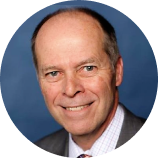Brett Knowles, pm2 Consulting
Brett is a long-time thought leader in the Strategy Execution space for high-tech organizations, beginning in the late 80’s while teaching at Harvard and being involved in the initial Balanced Scorecard research and books. His client work has been published in Harvard Business Review, Forbes, Fortune and countless other business publications.
Pub: April 29 2021
Upd: May 23 2023
OKRs are a crowdsourced methodology: there is no “one right way" to create them.
I have often said that one of the most interesting attributes of OKRs is how they are the first "crowdsourced" management best-practice. Here's what I mean - when you think of the Balanced Scorecard, you think of Kaplan & Norton, Re-Engineering is Michale Hammer, etc., but there is no single "creator" of OKRs (you could trace their origins back to Peter Drucker or Andy Grove, or the promotion of them to John Doerr), but there is no one source of the truth.
This means that there is no one person we can go to in order to find the "right way" to create OKRs. This is awesome because it means that you can build your OKR system in a way that works best for your organization without fear of retribution from the "OKR governing body". (That said - you are not the first organization on the OKR journey - there are a lot of 'best practices', use-cases, and experience that you need to leverage so as not to repeat previous organization's mistakes.)
So, the conversation to be had is about how to best create your own version of OKRs? Let's talk about Shu Ha Ri.
What is Shu Ha Ri?
Shu Ha Ri is a Japanese martial art concept that describes a progression of training or learning covering the stages of learning to mastery. Since there tends to be a lot of learning that happens in agile, a recent common application is in agile environments.
“It is known that, when we learn or train in something, we pass through the stages of shu, ha, and ri.
In shu, we repeat the forms and discipline ourselves so that our bodies absorb the forms that our forbearers created. We remain faithful to the forms with no deviation.
Next, in the stage of ha, once we have disciplined ourselves to acquire the forms and movements, we make innovations. In this process the forms may be broken and discarded.
Finally, in ri, we completely depart from the forms, open the door to creative technique, and arrive in a place where we act in accordance with what our heart/mind desires, unhindered while not overstepping laws.”
Endo Seishiro as quoted in Wikipedia
Applying Shu Ha Ri to OKR environment development
There is no question that every OKR implementation is different - between industry, location, strategic intent, data availability, meeting maturity and culture, we have never seen two identical situations. Still, it is valuable to ensure you have mastered the basics of OKRs before 'customizing' your approach. Essentially, start simple with the basics and do those well first, then move through Shu Ha Ri.
Here is a simple example: an organization wants to use OKRs to help as it is grappling with developing a new product/service offering.
- Shu: The team agrees to a clear product strategy and then creates a project of OKRs that align with that strategy, targets, and timing. They establish weekly OKR Performance Check-In meetings.
Once the team has deliberately followed this practice and exhibited a level of proficiency with it they are highly likely to have seen marked improvements in the project's progress, employee engagement and team agility.
- Ha: The team is now very happy with the improvements they have made and are encouraged to make their OKR instance better. So, they decided to change the format and cadence of their Check-In to a daily structure and added into outcome Key Results.
This change starts to yield improvements in performance and also in how the team collaborates. This continues for some time and the team continues experiments with various questions to augment or illuminate their current challenges.
- Ri: The team has moved away from the mechanistic structure of the Check-Ins and, when they can, update either O's or KR's. They also change the meeting cadence across the quarter based on which project phases are in play. Their new approach meets their needs of being quick, concise, impactful, and adapts easily to the situation the team is facing.
Your OKR Shu Ha Ri
The tricks to make Shu Ha Ri work in your organization are:
- Establish a solid OKR foundation based on best practices and build the organization's "muscle memory".
- Use your best team to begin making some OKR innovations, carefully monitoring what works and what does not work.
- Establish (and document) your best practices.
- Repeat.
The flexibility of OKRs allows us to adapt them into other methodologies and concepts that we find useful for our teams. This is just one of many examples on how OKRs can be used to your organization’s advantage.
Remember that here at Hirebook, we want you and your organization to thrive, and empower your employees towards bigger and better outcomes!
- Relevant
- Recent
- Topics
- Archive
- April 2023 (1)
- March 2023 (1)
- June 2022 (1)
- May 2022 (3)
- April 2022 (3)
- March 2022 (5)
- February 2022 (2)
- January 2022 (3)
- December 2021 (3)
- November 2021 (4)
- October 2021 (5)
- September 2021 (8)
- August 2021 (7)
- July 2021 (2)
- June 2021 (3)
- May 2021 (5)
- April 2021 (8)
- March 2021 (4)
- February 2021 (3)
- January 2021 (3)
- December 2020 (6)
- November 2020 (9)
- October 2020 (1)
- September 2020 (5)
- August 2020 (4)
- July 2020 (1)
Discover More Hirebook Posts








